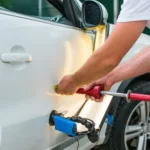Car maintenance is an integral part of vehicle ownership, yet many drivers find themselves unprepared when it comes to handling basic repairs, including hail damage repair. Being proactive and informed about essential car repairs can not only extend the life of your vehicle but also save you from costly repairs down the line. Below are some key car repairs every driver should know to keep their vehicles in optimal condition.
1. Oil Changes
One of the most critical aspects of car maintenance is regular oil changes. Oil lubricates the engine, reducing friction and preventing overheating. Over time, oil breaks down and becomes less effective, which can lead to engine wear. Most manufacturers recommend changing the oil every 5,000 to 7,500 miles, but it’s important to check your owner’s manual for specific guidelines.
How to Change Your Oil
Changing your oil involves:
- Gathering Materials: You’ll need new oil, an oil filter, a wrench, an oil catch pan, and a funnel.
- Lifting the Car: Use jack stands or ramps for safety.
- Draining Old Oil: Remove the oil drain plug and let the old oil drain into the catch pan.
- Replacing the Filter: Remove the old oil filter and install the new one.
- Adding New Oil: Replace the drain plug and pour in the new oil.
2. Tire Maintenance
Tires are your vehicle’s only contact with the road, making their maintenance crucial for safety. This includes regular rotation, alignment checks, and monitoring tire pressure.
Checking Tire Pressure
Proper tire pressure ensures optimal fuel efficiency and handling. Use a tire pressure gauge to check the pressure at least once a month. Inflate or deflate as necessary according to the recommended levels found in your owner’s manual or on the door jamb.
Tire Rotation and Alignment
Rotating your tires every 5,000 to 7,500 miles helps ensure even wear. If you notice your vehicle pulling to one side, it may need a wheel alignment, which can be done at most auto repair shops.
Door Ding Repair
Even with careful parking, it’s common for cars to acquire minor dents and dings, especially around busy areas. Door ding repair is a valuable skill for drivers, as these small imperfections can detract from your vehicle’s appearance and potentially lower its resale value. Most door dings can be repaired using paintless dent repair techniques, which preserve the original paint while restoring the metal to its original shape.
3. Brake Inspections
Brakes are vital for safety, so it’s essential to stay on top of their maintenance. Listen for unusual noises like squeaking or grinding, which can indicate worn brake pads.
How to Check Brake Pads
- Visual Inspection: Remove the wheel and look at the brake pads; they should be at least 1/4 inch thick.
- Testing: If your brakes feel soft or spongy, it might be time for a fluid replacement or a check for leaks.
4. Battery Care
A reliable battery is essential for starting your vehicle. Check your battery regularly for signs of corrosion, and ensure that the terminals are clean and tightly connected.
Testing Your Battery
You can test your battery with a multimeter to ensure it’s holding a charge. If your battery is more than three years old, consider having it tested at a local auto parts store.
5. Windshield Wipers
Clear visibility is crucial while driving, and effective windshield wipers are key to achieving that. Over time, wiper blades can become worn or cracked, leading to reduced visibility in rain or snow.
Replacing Wiper Blades
Replacing wiper blades is a simple task that can be done in minutes:
- Remove Old Blades: Lift the wiper arm and press the tab to release the blade.
- Attach New Blades: Follow the manufacturer’s instructions to install the new blades securely.
6. Light Replacement
Working lights are essential for safety, both for you and other drivers. Regularly check your headlights, brake lights, and turn signals to ensure they are functioning properly.
How to Replace a Bulb
- Access the Bulb: Open the hood and locate the light assembly.
- Remove the Old Bulb: Twist or pull the socket to release it.
- Install the New Bulb: Handle the new bulb carefully (avoid touching the glass) and secure it back in place.
Conclusion
Understanding these key car repairs can empower you as a driver and help maintain your vehicle’s performance. Regular maintenance not only enhances safety but also extends the lifespan of your car, ensuring that it remains reliable for years to come. Whether you choose to perform these tasks yourself or have a professional handle them, staying informed is the first step towards effective vehicle maintenance.




